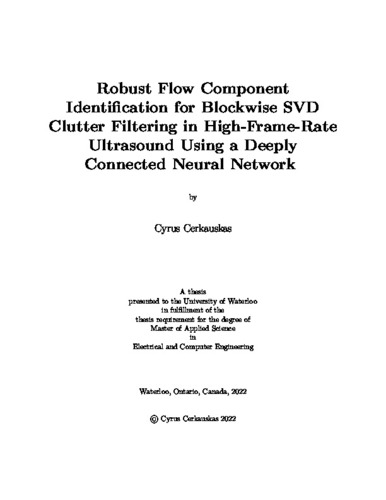| dc.contributor.author | Cerkauskas, Cyrus | |
| dc.date.accessioned | 2023-01-10 16:21:55 (GMT) | |
| dc.date.available | 2024-01-11 05:50:06 (GMT) | |
| dc.date.issued | 2023-01-10 | |
| dc.date.submitted | 2023-01-06 | |
| dc.identifier.uri | http://hdl.handle.net/10012/19045 | |
| dc.description.abstract | Ultrasound plays a critical role in the accurate and reliable observation of blood flow dynamics within the human body and is instrumental in the assessment of cardiovascular health and subsequent follow-up treatment. However, flow imaging innovations in ultrasound are dependent on the ability to remove the unwanted portion of the signal corresponding to static or slow moving tissues (or clutter ) from the dynamic blood signal. If this filtering process cannot be done to a high degree of precision, any corresponding flow image will be of low quality, corrupted by non-flow signals. Filtering is typically performed on the basis of frequency, using a high-pass filter. This approach functions well when the velocity distributions of tissues and flow signals are distinct but fails entirely when the two spectra overlap.
New types of filters in high-frame-rate ultrasound (HiFRUS) making use of both temporal and spatial information use the singular value decomposition (SVD) have been proposed. These filters function by decomposing the input signal into a series of orthonormal basis vectors or components. In theory, as tissue and flow signals posses different signal statistics, they should be decomposed into different components and readily identified. The identified flow components can then be reconstituted to produce a filtered flow signal. In practice, flow and clutter component identification is a challenging task considering the adaptive nature
of the SVD. Furthermore, flow and clutter signals may be mixed in the same components to varying degrees, making identification of flow signals a challenging task. While increased flow sensitivity and clutter rejection has been demonstrated by SVD filters, they currently lack the robustness required for clinical applications, often failing to perform in scenarios that challenge their innate assumptions of the flow signal decomposition. The goal of this work is to develop a robust generalizable flow identification framework that produces high quality filtered flow images across challenging in-vivo flow scenarios where current SVD filters demonstrate inconsistency. A deeply-connected neural network (DNN) was trained on a variety of flow acquisitions to reproduce the area under the curve (AUC) value obtained after performing receiver operator characteristic (ROC) analysis on the segmented flow region using a variety of statistical quantities correlated to the presence of flow in each component of the decomposition. The use of the AUC metric and subsequent training of the DNN using multiple statistical factors represents the first attempt at using a supervised learning approach to identify the flow components of the decomposition using many statistical factors simultaneously. When the proposed model was applied to acquisitions of an in-vitro flow phantom, in-vivo brachial artery, and in-vivo femoral arteries, greater sensitivity and specificity (measured using contrast and AUC) were obtained when compared to literature SVD techniques. The proposed model was also sufficiently generalizable to identify small blood vessels in the in-vivo human kidney.
The proposed methodology demonstrates an improvement on the performance and consistency of SVD filters, helping to put this powerful technique in the hands of more users. Furthermore, the supervised training methodology developed here, using ROC analysis to obtain an AUC value for each component that describes the spatial distribution of its signal power, has the potential to be extended to other clutter filtering algorithms potentially leading to better feature identification than current unsupervised techniques. | en |
| dc.language.iso | en | en |
| dc.publisher | University of Waterloo | en |
| dc.subject | ultrasound | en |
| dc.subject | clutter filtering | en |
| dc.subject | deeply connected neural network | en |
| dc.subject | singular value decomposition | en |
| dc.title | Robust Flow Component Identification for Blockwise SVD Clutter Filtering in High-Frame-Rate Ultrasound Using a Deeply Connected Neural Network | en |
| dc.type | Master Thesis | en |
| dc.pending | false | |
| uws-etd.degree.department | Electrical and Computer Engineering | en |
| uws-etd.degree.discipline | Electrical and Computer Engineering | en |
| uws-etd.degree.grantor | University of Waterloo | en |
| uws-etd.degree | Master of Applied Science | en |
| uws-etd.embargo.terms | 1 year | en |
| uws.contributor.advisor | Yu, Alfred | |
| uws.contributor.affiliation1 | Faculty of Engineering | en |
| uws.published.city | Waterloo | en |
| uws.published.country | Canada | en |
| uws.published.province | Ontario | en |
| uws.typeOfResource | Text | en |
| uws.peerReviewStatus | Unreviewed | en |
| uws.scholarLevel | Graduate | en |

